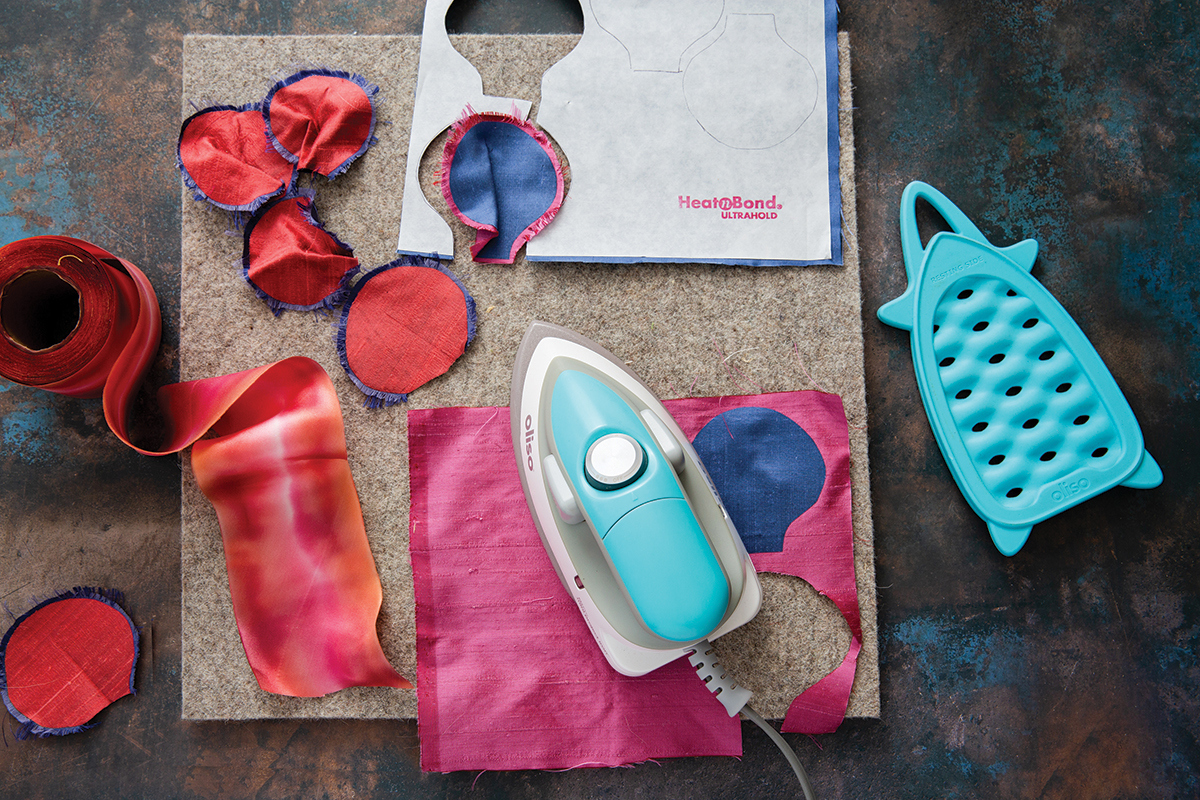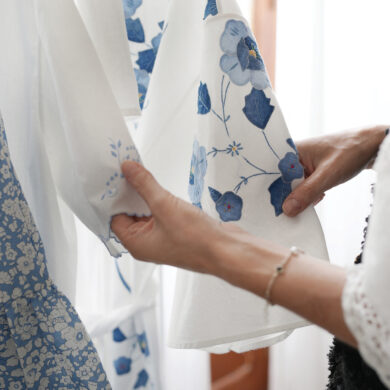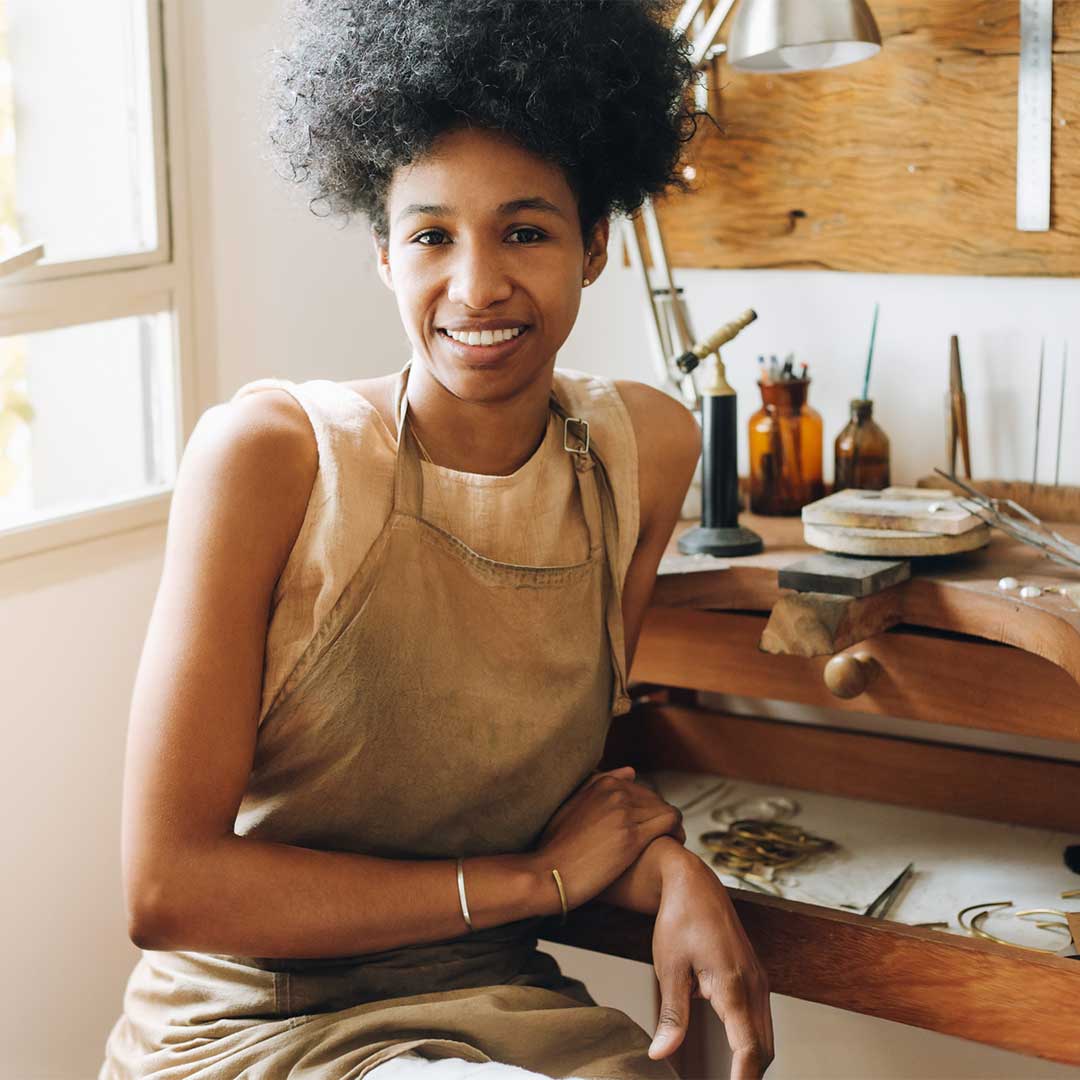 Making
Making
When I am creating pieces that are for a gift or for just the sake of seeing where the textiles and my mind take me, there are no limits. I usually have a basic idea of how I will start a flower but that can quickly change when I start to pull different textiles and discover how the fusible products I use change the texture, color, or hand of the fabric when heat is applied.
The individual techniques can be used on their own or collectively to make many different kinds of flowers.
Once you master each step, you can put them in a single flower or use them on their own for a simple bud.
Most of the silks in my collection are from my travels and a dear friend’s shop in Vermont. The hand-dyed silk and velvet ribbons and yard goods are from Hannah Silk.
 Teaching
Teaching
Designing flowers to teach in a workshop is a very different process than designing flowers for the sake of simply making. There are several constraints with class flowers. I have to consider the abilities of my students, whether the materials are readily available, and if I can write instructions that will be easy to follow. However, what I love most about teaching class flowers is that I can demonstrate each step using different fabrics, ribbons, and colors of thread, showing how these elements will change each piece to look completely like a different species. Using this technique is not only fun and inspiring; it also my students to see the possibilities of mixing textures, prints, and fibers to their advantage.
Giving
I like to give my favorite flowers to the people who I love!!
- A present topper instead of a card will ensure they will certainly know who it is from.
- The luscious hand-dyed velvets and woven printed silks in the these flowers and a box of handmade chocolates are an extravagant gift for someone as special as my mom.
- These linen leaves are fused to very stiff paper and sewn on the machine with pink thread because everything must be colorful and unexpected.
- The black flower stamens are vintage and part of my much-loved collection … they are in these blossoms because they are SO worth sharing with those who are are special to me.

Tools and Supplies
- Silk, velvet, and linen fabrics
- Oliso mini project iron
- Fusible paper-backed webbing by Thermo Web
- Scissors
- Jewelers’ pliers
- 18/20-gauge wire
- Fabri-Tac glue
- Craft paper for templates
- Brass molding tools
- Flatter by Soak
- Baste It by Roxanne

My process
Fabrics
My process always starts with the fabric. Usually just one piece begins my journey of pulling the fabrics I want to use in a single blossom or bouquet. Most of the time the fabric will also direct me to the type of flower I want to make.

Templates
Next I will pull from my existing templates or create new ones. I make my templates on brown paper, and if I think I will use them a lot, I trace onto card stock (cereal boxes!). I will also mix up the templates to create new flowers, a kind of hybrid. These shapes are inspired by real or vintage silk flowers that I love. Most of the leaves are just free formed by hand. I have always drawn from nature for my art.
Flower Petals
FUSIBLE WEBBING IN PETALS—The fusible webbing is sandwiched between 2 layers of fabric and left flat or molded with my hands and or tools
and will retain its shape when it cools down. It’s exciting to see how the intense heat from the iron transforms the fabric into malleable paper-thin pieces that are shaped into leaves and petals. I really pushed myself to come up with ways to manipulate the textiles I use to make my flowers with the mini iron. It really felt the safest way for me to create these in my home studio and to teach in person, online or in video classes.
FLOWER 1—Now that I have my fabric and fusible webbing sandwiches made and my shapes cut out, I want to start molding the shapes. Most of the layers will have a center indent that is created by a brass tool. I take the point of the iron and heat up the center. When it is sufficiently heated, I depress the brass tool into the center, holding it there until the fabric starts to cool. It will retain its shape nicely, especially if you use the Ultra Hold Heat ‘n Bond by Thermo Web.

FLOWER 2—Many of my blossoms use stuffed and tufted silk or velvet yo-yos for their centers. I started using them because it reminded me of the center of a poppy. Having had a very long love affair with yo-yos, it just stayed with me, and now it just seems to complete the blossom for most of my creations perfectly. I only use 100% wool stuffing; it has a dense quality about it, so it is much easier to handle and get it to conform to the shape you want over polyester.

FLOWER 3—Creating an elongated petal is very helpful when I apply high heat to melt the fusible webbing. This way, I have something to hold onto while I mold the petal with the brass millinery tool. The fusible webbing gets extremely hot and will hold the heat for several seconds. It can be difficult to handle, and you only have a few seconds before it begins to cool. You can reheat and start the process over once or twice before the fusible webbing begins to lose its structure.
The individual techniques can be used on their own or collectively to make many different kinds of flowers. Once you master each step, you can put them in a single flower or use them on their own for a simple bud. My dear friend and amazing quilt artist Allie Aller offered to send me her official flower-making tools on a long-term loan so I could try them out. I will admit, they far surpass my vintage melon baller and the end of my favorite pen to get the results I was looking for.
The 100% wool pressing mats I use have a bit of a give to them, so it helps mold the petal and leaves when I apply pressure. The wool is also a heat conductor and heats up the material from the bottom as well giving me the advantage of a completely malleable petal. The stems and cross-dyed silk strips are torn on the straight grain to get extra fray for some added whimsy.

Leaves
I often spend an afternoon creating several different types of leaves, so I can audition them with my different flowers. This way I can visualize the diff erent shapes and colors as I am either pulling fabrics or in the process of making my flowers.
I make a silk or linen sandwich with a fusible web and 18-gauge wire. I press right up against the wires, so it will look like the vines in a real leaf.

Stems + Attaching Leaves & Flowers
I tear long silk strips to wrap my stems. I use the pointed tip of the iron to press out the dupioni silk strips.
To create a long flower garland, I attach the flowers and buds to a wire. I start at one end and begin to wrap the silk on a diagonal and twist. When I want to add a flower I lay the flower’s wire stem along the garland wire and wrap the silk over both wires. To hide any unsightly ends, I use a fabric glue. I attach small leaves by gluing them in place where needed.

This bouquet is made with woven printed silk, dupioni, embossed silk velvet, vintage stamen and metal threads. I love adding various fabrics and fibers to create texture and interest. It’s about the layering for the fabrics for me. For many of the flowers, the center is often a stuff ed and or tufted yo-yo.

It really is the process of making something, successful or not, that brings me the most plea-sure and satisfaction. Once I achieve what I am envisioning, I need to move on to the next thing, or at least experiment with different textiles and fibers. Not all fabrics react to heat and fusible webbing the same. Occasionally, the results are bit of a surprise and lead me down a different path than I had originally anticipated. Spring is here, so you will find me in my garden getting more inspiration for my next fabric bouquet.















